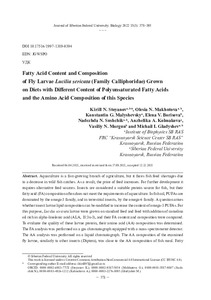Состав и содержание жирных кислот в личинках мух Lucilia sericata (сем. Calliphoridae), выращенных на кормах с разным содержанием полиненасыщенных жирных кислот, и особенности их аминокислотного состава
Скачать файл:
URI (для ссылок/цитирований):
https://elib.sfu-kras.ru/handle/2311/149184Автор:
Стоянов, К. Н.
Махутова, О. Н.
Малышевский, К. Г.
Борисова, Е. В.
Сущик, Н. Н.
Колмакова, А. А.
Моргун, В. Н.
Гладышев, М. И.
Stoyanov, Kirill N.
Makhutova, Olesia N.
Malyshevsky, Konstantin G.
Borisova, Elena V.
Sushchik, Nadezhda N.
Kolmakova, Anzhelika A.
Morgun, Vasiliy N.
Gladyshev, Michail I.
Дата:
2022-09Журнал:
Журнал Сибирского федерального университета.Биология. Journal of Siberian Federal University.Biology, 2022 15 (3)Аннотация:
Аквакультура – быстроразвивающаяся отрасль сельского хозяйства, однако
сейчас она столкнулась с недостатком кормов, основу которых составляют уловы дикой
рыбы, и, как следствие, повышением их стоимости. Для дальнейшего устойчивого развития аквакультуры необходимо разработать альтернативные корма, производимые не из дикой
рыбы. Насекомые рассматриваются как подходящий источник кормового белка для рыб,
однако их жирнокислотный (ЖК) состав часто не соответствует требованиям аквакультуры.
В рыбьем жире среди ПНЖК доминируют кислоты семейства омега‑3, а в наземных
насекомых – семейства омега‑6. Исследование возможности модификации ЖК состава
личинок насекомых для увеличения содержания омега‑3 ПНЖК является актуальной задачей.
Целью данной работы было изучить состав и содержание жирных кислот в личинках мухи
Lucilia sericata, выращенных на стандартном корме и корме с добавлением рыжикового масла,
богатом альфа-линоленовой
кислотой (АЛК, 18:3n‑3), и проанализировать аминокислотный
состав (АК) личинок данного вида мух. ЖК анализ проводили на газовом хроматографе с масс-спектрометрическим
детектором. АК анализ выполняли на жидкостном хроматографе. АК
состав исследованных личинок мух, как и других насекомых отряда Diptera, был близок к АК
составу рыбной муки. Состав и содержание жирных кислот личинок мухи на стандартном
корме характеризовались низким соотношением омега‑3 / омега‑6 ПНЖК и доминированием
18:1n‑9 и 18:2n‑6 – жирных кислот, которые суммарно составляли от 40 % до 60 % от суммы
ЖК. Добавление рыжикового масла изменило соотношение омега‑3 / омега‑6 ПНЖК с 0,11
до 0,46, главным образом за счёт увеличения содержания АЛК. Таким образом, ЖК состав
личинок L. sericata может быть существенно модифицирован пищей Aquaculture is a fast-growing branch of agriculture, but it faces fish feed shortages due to a decrease in wild fish catches. As a result, the price of feed increases. For further development it requires alternative feed sources. Insects are considered a suitable protein source for fish, but their fatty acid (FA) composition often does not meet the requirements of aquaculture. In fish oil, PUFAs are dominated by the omega‑3 family, and in terrestrial insects, by the omega‑6 family. A question arises whether insect larvae lipid composition can be modified to increase the content of omega‑3 PUFAs. For this purpose, Lucilia sericata larvae were grown on standard feed and feed with addition of camelina oil rich in alpha-linolenic acid (ALA, 18:3n‑3), and their FA content and composition were compared. To evaluate the quality of these larvae protein, their amino acid (AA) composition was determined. The FA analysis was performed on a gas chromatograph equipped with a mass-spectrometer detector. The AA analysis was performed on a liquid chromatograph. The AA composition of the examined fly larvae, similarly to other insects (Diptera), was close to the AA composition of fish meal. Fatty acid composition and content of fly larvae grown on standard food was characterized by a low ratio
of omega‑3/omega‑6 PUFAs and by the dominance of 18:1n‑9 and 18:2n‑6 fatty acids, which together
comprised 40–60 % of the total of FAs. The addition of camelina oil changed the ratio of omega‑3/
omega‑6 PUFAs from 0.11 to 0.46, mainly due to the increase in ALA content. Thus, FA content and
composition of L. sericata larvae can be significantly modified by a diet
Коллекции:
Метаданные:
Показать полную информациюСвязанные материалы
Показаны похожие ресурсы по названию, автору или тематике.
-
Structural and Functional Composition of Humic Acids Isolated from Soils of Natural and Urbanized Territories of the European Far North and the Arctic
Korelskaya, Tatiana A.; Prilutskaya, Natalia S.; Popova, Lyudmila F.; Корельская, Т. А.; Прилуцкая, Н. С.; Попова, Л. Ф. (Сибирский федеральный университет. Siberian Federal University, 2022-03)The structural and functional composition of humic acids in natural and urbanized areas of the European Far North and the Arctic has been studied using modern physical and chemical research methods. It is shown that the ... -
Regeneration of Hydrochloric Acid in the Catalytic Fructose Conversion to Levulinic Acid
Smirnova, Marina A.; Tarabanko, Valery E.; Chernyak, Michael Yu.; Смирнова, М.А.; Тарабанько, В.Е.; Черняк, М.Ю. (Сибирский федеральный университет. Siberian Federal University., 2014-03)The extraction method to regenerate hydrochloric acid as the catalyst of the fructose conversion to levulinic acid (LA) is developed. The influence of potassium chloride additions on the conversion and extraction processes ... -
Determination of Free Proteinogenic Amino Acids in Soil Solutions by HPLC with Phenyl Isothiocyanate Derivatization
Okunev, Rodion V.; Grigoryan, Boris R.; Sharipova, Adelina I.; Окунев, Р.В.; Григорьян, Б.Р.; Шарипова, А.И. (Сибирский федеральный университет. Siberian Federal University., 2014-12)A high-performance liquid chromatography method for the determination of seventeen free proteinogenic amino acids (FPAA) in soil solutions is described. Sample preparation involves obtaining soil solution and pre-column ... -
Sulfonation of Betulinic Acid by Sulfamic Acid
Левданский, В. А.; Левданский, А. В.; Кузнецов, Б. Н. (2015-10)Betulinic acid was sulfonated by sulfamic acid in the presence of urea in homogeneous 1,4-dioxane or DMF solution at 65–75°C in 2.5–3.5 h to give betulinic acid 3-sulfate, the structure of which was confirmed by IR and 13C ... -
Mercury, selenium and fish oils in marine food webs and implications for human health
Gribble, M. O.; Karimi, R.; Feingold, B. J.; Nyland, J. F.; O’Hara, T. M.; Gladyshev, M. I.; Chen, C. Y. (2016-02)Humans who eat fish are exposed to mixtures of healthful nutrients and harmful contaminants that are influenced by environmental and ecological factors. Marine fisheries are composed of a multitude of species with varying ...

